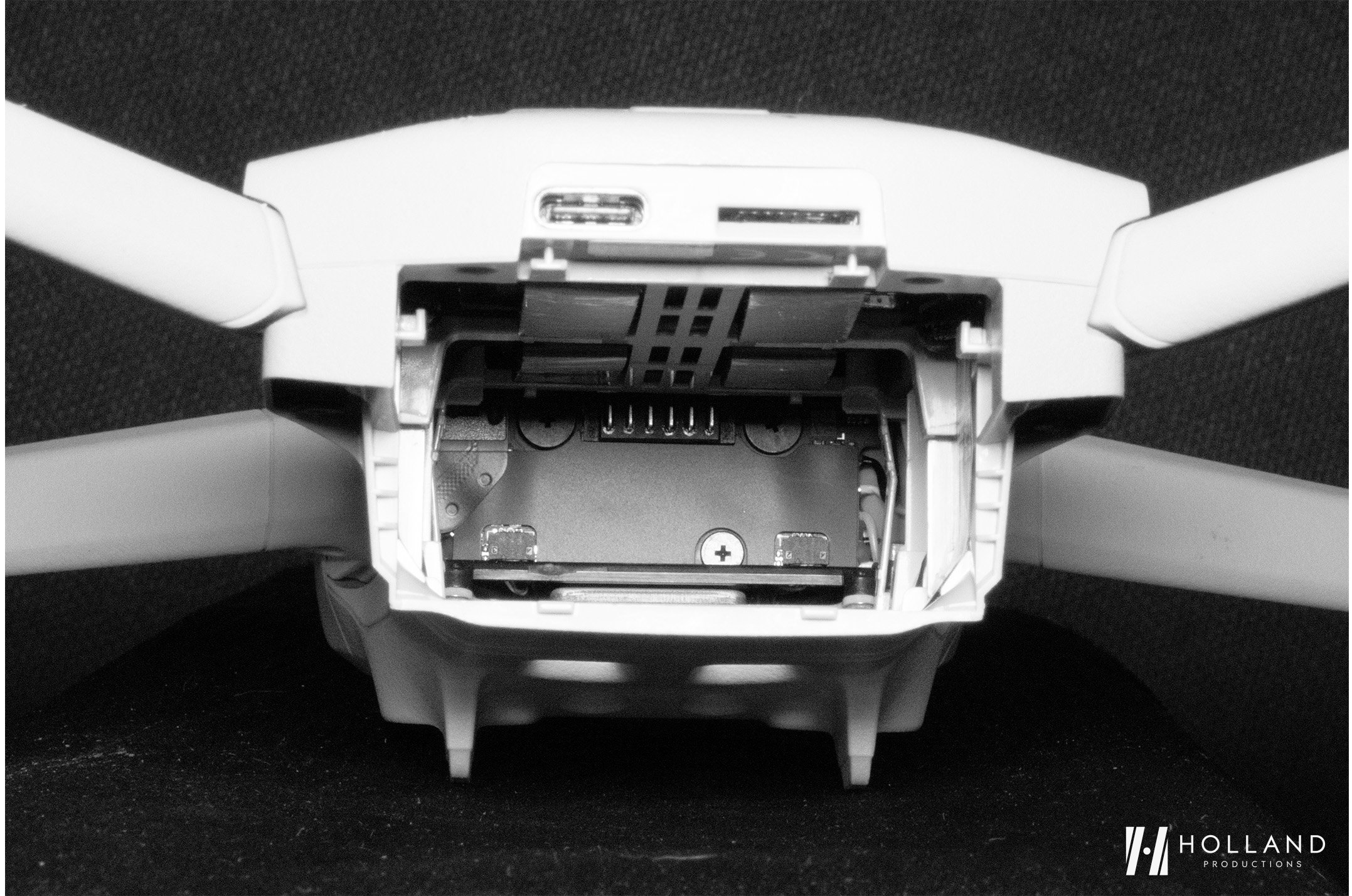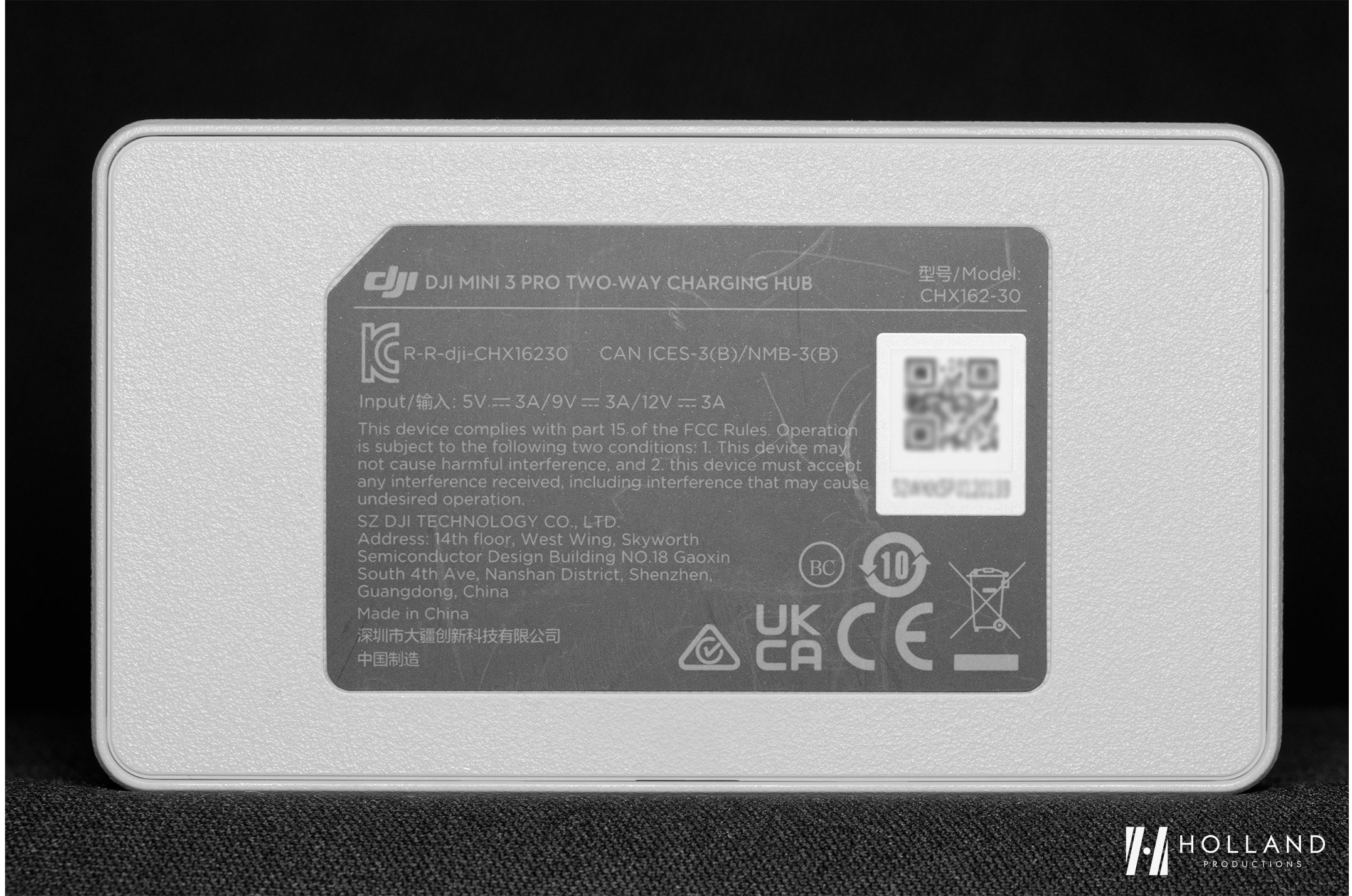Lithium Battery Safety for Drone Owners and Operators: Essential Guidelines and Best Practices.
Happy New Year from Holland Productions! I would like to start off 2024 with a blog post about Lithium batteries and the importance of battery safety.
After waking up on New Year's Day and pouring myself a coffee, I turned on the news to see that a fire broke out on a TTC (Toronto Transit Commission) subway car. The images were very scary seeing the entire subway engulfed in flames. It turned out that this fire was caused by a Lithium-Ion (Li-ion) battery on a e-bike. For the rest of the day I couldn't help thinking about the importance of Lithium battery safety, particularly related to drone operations. I think it is easy to take for granted the energy these batteries provide in such a small package. These batteries need to be treated and maintained properly to ensure everyone's safety. I will try to cover some important topics regarding drone LiPo battery safety and maintenance requirements.
Table of Contents
- Introduction
- Understanding Lithium Batteries
- Risks Associated with Lithium Polymer (LiPo) Batteries
- Routine Maintenance for Lithium Batteries
- Using the Correct Charger and Avoiding Overcharging
- Proper Storage of Lithium Batteries
- Disposal and Recycling of Lithium Batteries
- Conclusion: Emphasizing the Imperative of Lithium Battery Safety
- Additional Resources
Introduction
Lithium-ion (Li-ion) and Lithium Polymer (Li-Po) batteries have become a staple energy storage source in a vast array of electronics. From the smartphones we carry around in our pockets to the drones we fly in the sky, lithium batteries have become a cornerstone due to their efficiency and small form factor.
A recent study from ScienceDirect.com goes deeper into the technology and use of Lithium batteries for UAVs and how lithium batteries are the preferred choice for UAV and drone applications even with the trade off of lower flight times compared to other battery technologies. The study also discusses concerns around sustainability when choosing battery technology.
Understanding Lithium Batteries
How Lithium Batteries Work
Lithium-ion (Li-ion) and Lithium-polymer (LiPo) batteries are two of the most widely used rechargeable batteries in most electronic devices, each with its distinct characteristics and applications.
Lithium-ion batteries are widely used for their high energy density and cost-effectiveness but come with certain safety concerns and a rigid form factor. Lithium-polymer batteries, while slightly less energy-dense, offer more flexibility in design, lighter weight, and enhanced safety, making them suitable for applications where form factor and stability are crucial. The choice between Li-ion and LiPo often comes down to the specific needs of the device they are intended to power, balancing factors like cost, energy requirements, safety, and design flexibility.
The sophisticated chemistry behind lithium batteries is detailed in various studies and articles, including in-depth resources on ScienceDirect that explore their engineering and design aspects.
Common Uses of Lithium Batteries
The ubiquity of lithium batteries in modern technology is hard to overstate. They are essential in powering a wide range of devices, each application taking advantage of their unique properties.
Drones benefit immensely from mainly lithium polymer (LiPo) batteries' high energy-to-weight ratio, which is crucial for maintaining longer flight times without adding excessive weight.
In smartphones and laptops, the compact size and longevity of lithium batteries have enabled these devices to become increasingly powerful and portable. The ability of lithium batteries to efficiently store and release energy also makes them ideal for applications requiring a reliable power source over extended periods. This has led to their widespread adoption in everything from portable consumer electronics to electric vehicles, and even in larger-scale applications like renewable energy storage systems.
The versatility and efficiency of lithium batteries, as explored in various engineering studies, underline their critical role in the ongoing evolution of technology and their potential for shaping a more sustainable future.
Because most modern drones use LiPo batteries, I will focus the rest of the blog on LiPo batteries as it relates to drone owners and operators.
Risks Associated with Lithium Polymer (LiPo) Batteries
Potential Hazards Specific to LiPo Batteries
Lithium-polymer batteries, while offering flexibility and lighter weight, carry distinct risks, primarily due to their composition and the way they are constructed.
Vulnerability to Physical Damage: LiPo batteries are more susceptible to damage due to their soft, flexible packaging. Punctures or severe impacts can compromise the integrity of the battery, leading to short circuits.
Swelling and Puffing: LiPo batteries can swell or 'puff' if overcharged, discharged too quickly, or damaged. This swelling is a sign of gas build-up inside the battery and can lead to rupture or combustion.
Sensitive to Overcharging: Overcharging a LiPo battery will lead to degradation of the LiPo battery and can also lead to thermal runaway which can cause a fire.
Higher Risk of Fires in Case of Failure: While LiPo batteries are generally considered safer than traditional Li-ion batteries in terms of chemical stability, their failures can be more dramatic, often resulting in intense fires that are difficult to extinguish.
Routine Maintenance for Lithium Batteries
Maintaining lithium batteries, especially lithium-polymer (LiPo) batteries, is crucial for prolonging their life and ensuring safety. Here are some key tips and practices for routine maintenance for drone LiPo batteries:
Regularly Checking Battery Health
Voltage Monitoring: Regularly check the voltage of each cell in a LiPo battery. Cells with significantly different voltages may indicate a problem.
On DJI drones this can be accessed by tapping on the 3 dots in the top right corner of the DJI App.
First put the battery in the drone that you would like to test.
Power on RC Controller and or phone application depending on the model of controller.
Power on the drone and let it start up.
Ensure your drone and battery have the latest firmware.
Once powered on with all firmware up-to-date, touch the 3 dots in the top right corner of the controller screen.
DJI FLY APP Screenshot
This will bring up the main settings menu of the drone.
Click on the first tab “Safety”. Then click on Battery Info, to access the next screen for the battery information.
DJI FLY APP Setting Screenshot
This will bring up the battery information for the current battery in the drone.
DJI FLY APP Battery Info Screenshot
In this example I am using the DJI Mini 3 Pro drone with the Intelligent Flight Battery, not the intelligent flight battery plus.
Capacity Checks
You can see that this LiPo battery has 2 cells and each cell is showing 4.08 V on full charge for a total battery voltage of 8.16 V after about 3 minutes of the drone being powered on. This is a good sign because the battery cells are showing the same voltage between the two cells, meaning the charger balanced the charge between the cells and the cells are showing balanced voltage at full charge. If these cells were not even after fully charging and left idle for 6 hours, for example, cell 1 showing 4.08 and cell 2 showing 4.07 V, a 10mV difference, this could indicate that there is an issue with the charger or the battery itself. Checking your other batteries with the same charger would help determine which is the culprit.
I mark all my batteries with a number that corresponds to the serial number of the battery and I track all the battery cycle counts and the test dates.
Test dates include quarterly full charge cell voltage checks as well as battery temperature checks after powering the drone on idle for 10 minutes.
I then mark down the stats in a spreadsheet for the entire fleet of drones and batteries.
A significant drop in capacity can be a sign of aging or internal damage.
Never sell your drone and/or batteries if you suspect capacity issues.
Physical Inspection:
The actual LiPo battery model number can be found on the physical battery, along with the safety certifications listed on the battery:
DJI Mini 3 Pro Battery (BWX162-3850-7.38)
You can see that the DJI Mini 3 Pro Intelligent Battery is model BWX162-3850-7.38
During your regular maintenance checks, look for signs of physical damage, like swelling, discoloration, dents, cracks or leakage. If you notice any swelling immediately discontinue use of the battery as swelling is a key indicator that there are issues with your LiPo battery.
You should also check the battery terminals for any corrosion or bend terminals. The terminals should be clear of debris and in good condition.
A well maintained battery can last up to 200 cycles before needing to be retired and properly disposed of. Discharging the battery fully prior to disposal is very important.
Physical inspection of the terminals on the charging station is also very important to ensure the terminals are also free and clear of debris and not bent or show signs of excessive wear.
DJI Mini 3 Pro Battery Charging Hub (CHX162-30) - Top View
Another important place to inspect is the battery terminals on the drone itself to ensure the terminals are in good condition and free of debris or excessive wear.
DJI Mini 3 Pro Battery Terminals
Using the Correct Charger and Avoiding Overcharging
Using the Correct Charger and Avoiding Overcharging
DJI Mini 3 Pro Battery Charging Hub (CHX162-30) - Side View
Charger Compatibility
Only use chargers that were supplied and designed to be used with your drone LiPo batteries.
These chargers were designed to balance charge the LiPo batteries properly and avoid over-charging individual cells.
Never use third party chargers for your drone smart batteries.
All LiPo battery chargers approved for use in Canada must be cUL certified and you can look up the model number on cUL website to ensure authenticity.
Check the model number on the bottom of the charger, for the Mini 3 Pro Intelligent Battery, the charger is model: CHX162-30.
DJI Mini 3 Pro Battery Charging Hub (CHX162-30) - Bottom View
You can then go to the cUL website and cross reference the cUL certification for Canada:
Never use third part LiPo chargers that were not designed for use with your drone for your safety and the safety of others.
Avoid Overcharging and Over “Discharging”.
It is very easy to become too laxed with modern drone LiPo batteries and drones. The technological advancement with these smart batteries takes a lot of the guesswork out of the really science of how these batteries should be maintained. Don’t take this technology for granted, and please be mindful when charging your LiPo batteries.
Never leave your batteries unattended and always disconnect the battery once fully charged. Overcharging can lead to overheating and potential hazards like thermal runaway.
Whilst modern drone LiPo batteries have many smart features built-in to automate this process, you still have to be mindful of the immense energy these small batteries pack and the potential for fire hazards if anything goes wrong.
If drone LiPo batteries are left idle at a very low charge, they can over-discharge.
For long-term storage (10 days or more), discharge the battery to 40%-65%.
Store the battery in a dry, cool environment (22°C-28°C).
Every three months, fully charge and then discharge the battery.
After fully charging, attach it to the aircraft and use it until it reaches 65% for storage.
Proper Storage of Lithium Batteries
The way lithium batteries, especially LiPo batteries, are stored plays a crucial role in their longevity and safety. Here are key considerations and best practices for storing these batteries:
Best Practices for Storing Lithium Batteries
Store LiPo batteries at a 40-60% charge level. Storing them fully charged or fully depleted can lead to decreased battery life and increased risk.
Store LiPo batteries in fireproof containers or specifically designed LiPo bags. This can help contain any fires that might occur if a battery fails.
Store batteries in a dry, cool place away from flammable materials. It's advisable to store them separately to prevent chain reactions in case of a failure.
Temperature Considerations and Impact of Extreme Conditions
LiPo batteries should be stored in a cool and dry environment. Extreme temperatures, both hot and cold, can degrade the battery's performance and increase the risk of failure.
Never leave batteries in a vehicle in the summer. The heat inside a vehicle with the windows up and vehicle (A/C) off can raise the temperature drastically in a short period of time.
As mentioned earlier, the recommended storage temperature of LiPo batteries is 22°C-28°C.
If the outside ambient temperature is within our optimal battery range of 22°C-28°C, the inside temperature of a vehicle after 60 minutes can reach 45.9°C - 51.9°C.
This will certainly cause permanent damage to your LiPo batteries after a short period of time.
Holland Productions uses dry coolers to keep batteries stored in extreme temperatures to maintain optimal storage temperatures. Please reach out to us for more information.
High humidity or exposure to moisture can damage the battery. Moisture can lead to corrosion or short circuits within the battery.
Flying through dense fog is a condition most drone operators will have to deal with at some point, whether it is for a creative shot or capturing construction monitoring images, and as long as the flight is relatively short and the batteries and drone are inspected once landed, this can be performed safely.
If you plan to store the battery for an extended period, periodically check the charge level and overall condition. Batteries left unused for long periods can degrade.
4.3 Safe Transportation Guidelines
When transporting, carry LiPo batteries in fire-resistant cases or bags. These are designed to contain any potential fires.
Protect the batteries from being crushed or punctured. Physical damage is a major risk factor for LiPo batteries.
Be aware of airline regulations regarding LiPo batteries. They are typically required to be carried in carry-on luggage, and there may be restrictions on their capacity.
Clearly label the batteries and carry necessary documentation, especially for air travel, as airlines often have specific requirements for transporting lithium batteries.
Proper storage and handling of lithium batteries, particularly LiPos, are vital for safety and performance. Understanding and adhering to these guidelines can significantly reduce the risks associated with these batteries.
Disposal and Recycling of Lithium Batteries
Importance of Proper Disposal
Environmental Hazards: Incorrect disposal of lithium batteries can lead to environmental contamination due to their toxic components.
Safety Risks: Improperly discarded batteries pose a fire risk, as damaged batteries can spontaneously ignite.
Resource Recovery: Proper disposal allows for the recovery of valuable materials used in battery production, supporting sustainable resource management.
Resources and Locations for Safe Recycling
Recycling Centers: Many communities have dedicated centers or drop-off points for recycling batteries.
Retailer Programs: Some electronics retailers offer take-back programs for used batteries.
Manufacturer Initiatives: Check with the battery or device manufacturer for specific recycling programs or guidelines.
Proper disposal and recycling of lithium batteries are critical for environmental protection and safety. Users should utilize local resources and follow guidelines set by manufacturers and environmental agencies for responsible battery disposal.
Conclusion: Emphasizing the Imperative of Lithium Battery Safety
In conclusion, the safety of lithium batteries, particularly in the context of their widespread use in modern technology, cannot be overstated. From understanding their functionality to implementing best practices for usage, maintenance, storage, and disposal, each aspect plays a crucial role in ensuring safety and efficiency. As we have discussed, the risks associated with improper handling of lithium batteries, such as fires and explosions, underscore the necessity for vigilance and adherence to guidelines.
I urge readers to not only internalize these practices but also to advocate for and educate others about the importance of lithium battery safety. Whether you're a drone hobbyist, a smartphone user, or an electric vehicle owner, integrating these safety measures into your daily routine can make a significant difference in preventing accidents and prolonging the life of your devices. Let's collectively commit to responsible lithium battery usage for a safer and more sustainable future.
Additional Resources
https://toronto.citynews.ca/2023/10/24/toronto-lithium-ion-batteries-fires-ebikes/
https://globalnews.ca/news/10199944/e-bike-fire-ttc-subway-safety-concerns/
https://www.sciencedirect.com/science/article/pii/S2095495620307075
https://www.canada.ca/en/health-canada/services/household-products/battery-safety/lithium-ion.html
https://www.sciencedirect.com/science/article/abs/pii/S2451904923000306
Drone RPAS UAV sUAS











